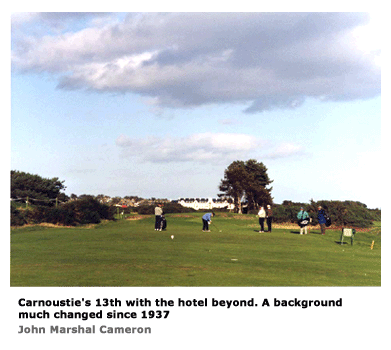|
| |
|
News tournament at
Temple Newsam, Leeds, where she was assistant to the club’s pro -
her brother Syd, a good player who had several high finishes in the
Open in the twenties and was = 5th in 1925. She was the first woman
who ever played in men’s professional events and was followed by a
large crowd. Women were expected to dress conservatively on the golf
course at that time and there had been a big ‘hoo-ha’ when trousers
were worn for the first time at the 1933 English Women’s’
Championship by Gloria Minoprio who, incidentally, played with only
one club-a long-shafted straight faced iron. In the same year the
wearing of waterproof trousers in a Lady’s event at Stoke Poges was
frowned upon, but had been reluctantly accepted by the time of the
1935 English Women’s Championship at Birkdale, played in foul
weather. Nevertheless Poppy’s outfit was still of great interest to
the newspapers and they reported that “Miss Wingate was dressed in a
grey skirt, grey jumper and matching shoes”. (A pair of her shoes
can be seen in the Golf Museum at St Andrews). With all the ballyhoo
she did well to score 85. She was at a big disadvantage compared
with the modern ‘power players’ in the Women’s game, often needing
three wood shots to reach the longer holes. Surprisingly, she was
not the only woman to play in a men’s tournament in those days and
the papers reported that Meg Farquhar, assistant at Moray GC, played
in the Scottish Professional Championship at Lossiemouth shortly
afterwards. Some, including Archie Compston, who coached 19-year-old
Pam Barton, winner in 1936 of the British and American Ladies
Amateur Championships, were saying that it was only a matter of time
before women were challenging for the Open. Almost seventy years
later that prediction is still to be fulfilled, but it is now edging
closer to reality. Later that month I won the Dunlop Northern Tournament at the City of Newcastle Golf Club at Three-Mile Bridge. My opening 70 took the lead and I held on with a final round 74 to pip Laurie Ayton (South Shields) by one, in wet conditions that would certainly cause abandonment today. Among those sloshing through the puddles was 6th placed Percy Alliss, who by then had succeeded Syd Wingate at Temple Newsham and my brother Charles, who finished with a 73 to take a share of 7th. After that, as the season progressed, although I was hitting the ball well nothing seemed to happen. My scores were good enough to make the cuts but I was not getting into contention and my confidence was draining away.  Carnoustie was the venue for the 1937 Open and I well remember the
long rail journey north from Liverpool Lime Street to Dundee, where
I stayed in a boarding house recommended by a West Cheshire member.
It was only the second time that the championship had been held on
this huge links, which has earned a reputation as the toughest test
on the championship rota. That year the course was at its full
length, well over 7000 yards with extra bunkers strategically
placed. It was no place to be when your confidence was reaching its
nadir. Carnoustie was the venue for the 1937 Open and I well remember the
long rail journey north from Liverpool Lime Street to Dundee, where
I stayed in a boarding house recommended by a West Cheshire member.
It was only the second time that the championship had been held on
this huge links, which has earned a reputation as the toughest test
on the championship rota. That year the course was at its full
length, well over 7000 yards with extra bunkers strategically
placed. It was no place to be when your confidence was reaching its
nadir. Just as in 1999 there were rumblings about the severity of the course and the press were saying that the Carnoustie authorities had declared war on the modern ball, modern clubs and the modern player’s ability to drive terrific distances. The general opinion was that they had won the battle hands down and produced “the most heartbreaking course ever presented to an Open field”. Worse still, as a public links in heavy use until a week or so before the championship, it was in poor condition. |
